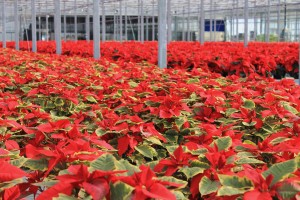Poinsettias
I like poinsettias and buy one every year. And every year the poinsettia industry produces new colors and shapes for the “flowers”. Standard red has given way to pink, maroon, white and red, pink and red; simple bracts are now double, double with ruffles. There is always a call for the new and different. Me? I’m a simple gardening guy who likes the simple old fashioned kind.
Botanically speaking, those red parts of a poinsettia are actually called bracts. The flowers are the tiny yellow center of each “flower”, and the red bracts are leaves purely for decoration – and an advertisement to any stray pollinator (or shopper) that might be around.
Poinsettias are native to Mexico, and were first introduced to the United States in 1828 by President Andrew Jackson’s ambassador to Mexico, Joel Poinsett. But they have traveled the world. When I was working in Bamako, Mali, West Africa, in the early 1980’s, I had hedges of poinsettias that were five feet tall. But it took a long time for poinsettias to become popular.
In 1923 a grower named Paul Ecke started growing them in quantity in California, selling plants wholesale and shipping them by rail all over the country. He worked on growing good, durable plants that he sent to growers so that they could start cuttings and make more plants. He was a trained horticulturist, but also a good marketer. He gave free plants to TV hosts like Johnny Carson and Bob Hope for his Christmas Special every year. Through the magic of TV he got Americans to associate the idea of Christmas with poinsettias.
One reason that poinsettias are so popular is that they are easy to keep looking nice – even those folks with “brown thumbs” can keep them going for a couple of weeks or more. They are almost like plastic plants. And most of us feel no guilt about throwing them out when they start to look ratty.
If you’ve never offered a home to a poinsettia, here’s what you need to do: Water it once a week, give it some indirect light, and avoid placing it in a cold or drafty place. Temperatures of 68 to 72 are recommended, but my house is rarely that warm, and they do fine for me. And don’t put it on top of a radiator or anywhere where it will get too hot and dry out too quickly.
The worst thing you can do for a poinsettia is to overwater it. Too much water will rot the roots, and your holiday plant will go into a decline and die. I lift the pot and can tell by its weight whether it needs water or not. But you can stick your finger in the soil, too. If it is wrapped in foil, make a hole in the bottom so that excess water can drain into the saucer.
Getting poinsettias to bloom in their second year is complicated, and not worth the effort for most of us. One must give them bright light during the day, and no light at all for 12 hours or more – which means moving them into a closet or basement, and remembering not to turn on the light. I have read figures citing 5 days of dark treatment as adequate, but also up to 10 weeks of dark from 5pm to 8am. Who knows? I once read read that a big grower had trouble getting his plants to develop their red leaves simply because he had a night watchman who liked plants and shined his flashlight around the greenhouse on his nightly rounds.
My mother, may she rest in peace, never had poinsettias because she believed, mistakenly, that they were poisonous. She feared that her cat would eat a leaf and die. I told her that was not the case, but she was a worrier, and wouldn’t take a chance with her dear cat, Bella (may she, too, rest in peace).
Ohio State University in cooperation with the Society of American Florists did a study that proved that poinsettias are not the threat my mom believed they were. Yes, they are in the genus Euphorbia, a group of plants that have alkaloids in their white sap. But the sap is not very toxic. According to the Mayo Clinic web site, poinsettias are not good to eat, and might cause a tummy ache or a rash, but unless you are allergic to them, nothing serious is likely to happen if you make them part of your lunch. Or your cat’s lunch.
From a Darwinian point of view, it might make sense for a plant to make itself poisonous, or at least unpleasant to eat. After all, plants want to reach maturity and produce seeds, allowing their genetic material to be passed on to the next generation. They don’t want all their leaves to be eaten before maturity. But the bottom line is, feed your cat well, and she probably won’t even get a tummy ache from nibbling your poinsettia.
So get yourself a poinsettia. They will provide some nice color on your table for the holidays. Just don’t water it too much.
Henry Homeyer is the author of 4 gardening books. His Web site is www.Gardening-Guy.com.



